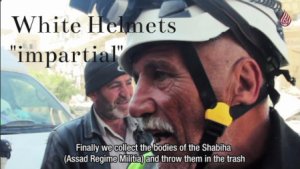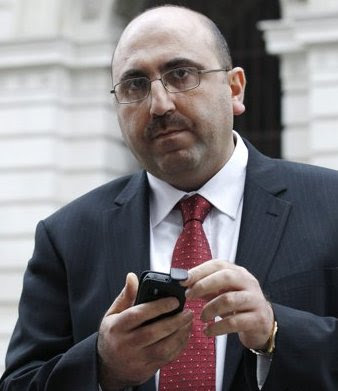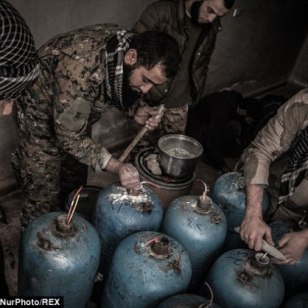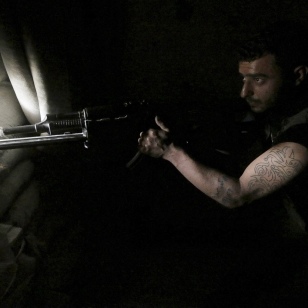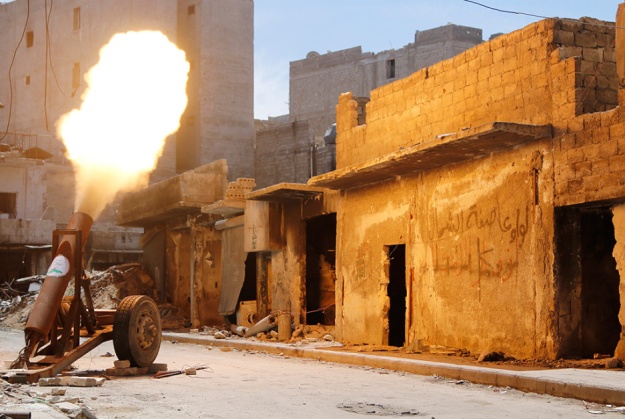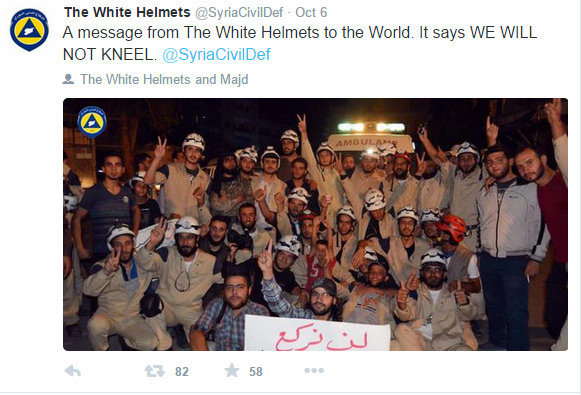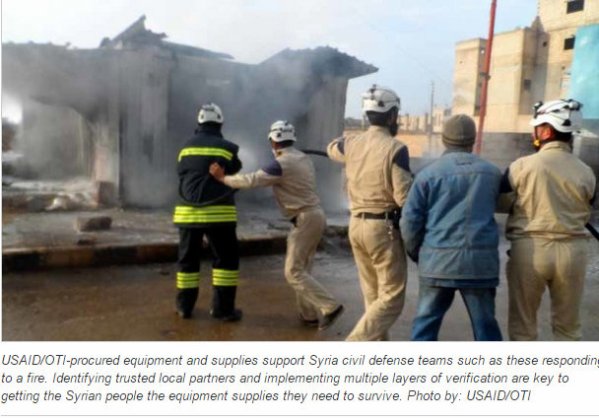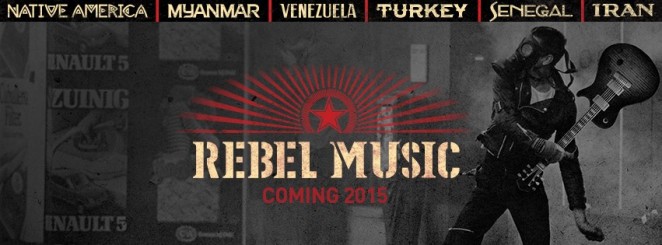Oct 28
20150
Foundations, Non-Profit Industrial Complex, The International Campaign to Destabilize Syria, Whiteness & Aversive Racism
Al Nusra British Foreign Office George Soros HRW Iraq ISIS James Le Mesurier Libya NGO Soft Power Complex Psyops Purpose Inc. R2P Syria Syria Civil Defence Syrian National Council Syrian Observatory For Human Rights (SOHR) The White Helmets USAID
Part II – Syria’s White Helmets: War By Way of Deception — ‘Moderate Executioners’
October 27, 2015
by Vanessa Beeley
[Part one: Syria’s White Helmets: War by Way of Deception]
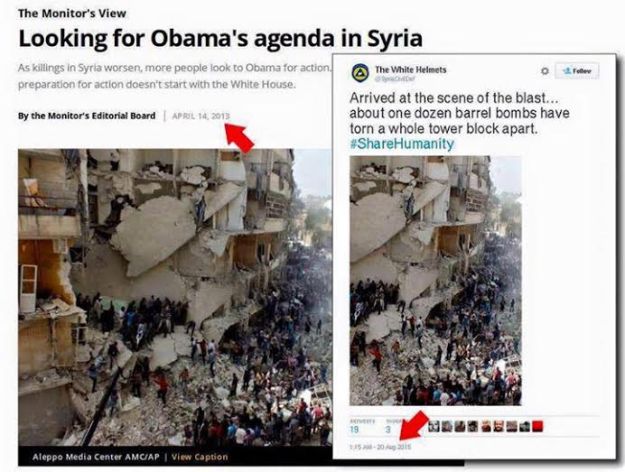
“If there is any doubt concerning the nefarious undertones of subversiveness in these NGO dealings, [National Endowment for Democracy] NED founder reportedly said the following in the 1990s: ‘A lot of what we do today was done covertly 25 years ago by the CIA.’ What was once done at night under the cloak of ‘imperialism’ is now done during the day under the guise of ‘humanitarianism.” ~ The Wrong Kind of Green
Hindsight is a generous provider of absolution of the guilt from falling for the sophisticated western government or state propaganda and their media sleights of hand that so often deceive us into believing the narrative they present, one that’s so often designed to justify military intervention.
Invariably this is a narrative that all but ensures the massacre of innocent people under the pretext of ‘liberating’ them, or introducing ‘democracy’ that always promises to erase some perceived grievance of an western-backed opposition movement. Western nation-builders normally prescribe the same treatment every time: cutting a swathe through the host country’s society and culture either via proxy armies of foreign mercenaries under the guise of various terrorist factions or with an onslaught of bombs and assorted mass destruction or chemical weapons (including depleted uranium) which can render their land barren for decades and result in birth defects, increased cancer rates and a multitude of devastating side effects for generations after. While all this is going on, a parallel government has already been formed by the west, laying in waiting in some five star hotel in Paris or London.
Despite such hindsight and the universally accepted knowledge that it was in fact pure fiction that took us to war in both Iraq, and in Libya too, there is still a huge degree of cognitive dissonance at play over the Syria commentary. The lies regarding Syria, lies which are designed to justify western military intervention and arming proxy militants, are ongoing. Even today the New York Times provided a key Washington propaganda talking point in its headline which reads, “Violence in Syria Spurs a Huge Surge in Civilian Flight“, with the important subheading which states: “Government Offensives and Russian Strikes Are Catalysts“, essentially blaming Russia’s three week old air campaign for the “surge” of refugees entering Europe through Greece, all the while neglecting to mention most of these originate from the pool of almost 2 million who have been languishing in Turkey from as early as 2012. Like clockwork, western propaganda mills continues, all day, every day.
Disbelief is invariably registered when it is demonstrated that Syria is undergoing the same ‘truth laundering’ treatment as Libya and Iraq underwent previously, or that Syria’s resistance of the West’s open attempt at regime change attempts for nearly 5 years now is the reason for repeated spikes in propaganda. We’ve seen many different versions of the West’s creative narrative at any give moment, especial when Syria or its allies persistently thwarts the Colonialist vision for the region. Failed policies never play well on CNN or the BBC in real time, with any serious criticism reserved until a decade has passed and it’s safe for media operatives to comment because the politicians who sold those failed policies have since retired or have been cycled out of foreign policy decision-making positions.
Lethal Weapon: NGO Soft Power
“Along with military invasions and missionaries, NGOs help crack countries open like ripe nuts, paving the way for intensifying waves of exploitation and extraction” ~Stephanie McMillan
The NGO ‘soft power complex’ is now one of the most destructive global forces. It is employed as an interface between civilians of a target nation, with government, economic or military structures of the colonialist force intent on harnessing any given nation’s resources or undermining its geopolitical influence. The Democratization process, or the path to regime change is facilitated by these undercover government or corporate proxy employees who, once embedded into a society, set about producing the propaganda that will justify intervention, either economically, politically or militarily. NGO propaganda will often employ slick social media marketing which is underpinned by advance applied behavioural psychology and advanced NLP-based ‘social enterprise’ sales pitches.
A recent piece by researcher Eva Bartlett entitled, “Human Rights Front Groups [Humanitarian Interventionalists] Warring on Syria“, provides a detailed insight into how this new breed of weaponized politics is being deployed right now in the Middle East.
The perception of a ‘non profit’ complex who purport to be “working for the betterment and improvement of humanity” can be a difficult nut to crack, but it must be done. In the west. charities, not-for-profits and Non-Governmental Organisations (NGOs) are seen as “do gooders” and so they rarely fall under public scrutiny. Western governments know the general public has an inherent faith in their perceived integrity and this provides an ideal cover for western government and intelligence agencies to operate through their NGO and aid organisations.
Syria: Under Seige
As Paul Larudee states in his article, Mythology, Barrel Bombs and Human Rights Watch:
“The Syrian army relies on loyal soldiers defending their country and their homes from a heavily subsidized, markedly foreign incursion, including many mercenaries paid by the Gulf monarchies and trained by the US. And the army is loyal because they know that although great sacrifices will be asked of them, they will be defending, not sacrificing, their families and loved ones. The rest of the world that supposedly cares about Syria can start by making it unnecessary for them to make such sacrifices.”
Much of the propaganda surrounding Syria and the “conflict” is indeed, mythology spun-up by western agents of influence. A mythology created and disseminated by the NGO complex working diligently on the ground in Syria and remotely in the labyrinths of power, ensures that a steady flow of misinformation continues uninterrupted, one that is custom designed to alter public perception about the situation in Syria and drive us towards supporting the identical mistakes made in Iraq and Libya.
It is no error or oversight that the media barely mention Libya these days as it is plunged deeper and deeper into anarchy, where warlords occupy the terror vacuum created by the NATO’s deceptive intervention in 2011. Perhaps if people were confronted by images of the daily horrors endured by the people of Libya these day, they would be more reticent about the passive-aggressive re-creation of that same scenario in Syria.
The White Helmet Myth
The NGO hydra has no more powerful or influential serpentine head in Syria than the Syria Civil Defence aka The White Helmets who, according to their leader and creator, James Le Mesurier, hold greater sway than even ISIS or Al Nusra confabs over the Syrian communities.
As we pointed out in Part I of this exposé, The White Helmets humanitarian front is mainly financed by the British Foreign Office. According to Richard Spencer of the London Telegraph:
“The Foreign Office is currently the largest single source of funding. It is an irony that if Britain does effectively become an ally of Assad, and starts raids against Isil in Syria, it will be bombing from the air and paying for the bodies to be dug out on the ground. The White Helmets are also operating in at least one Isil-held area.”
In a speech given by Le Mesurier in Lisbon June 2015, entitled “Act 1: Witnesses to history in the making”, Le Mesurier informed his rapt audience that in a recent US Government survey conducted across a “diverse spectrum” of Syrian communities, 67% of those asked, nominated the White Helmets as the most influential community organisation. This, despite, their non-inclusion in the 15 respondents to the survey, that comprised ISIS, Al Nusra, & other political or armed groups. This is a bizarre claim on two fronts:
1. That the White Helmets should be included in this list, by James Le Mesurier, his NGO is a group that promotes themselves to be “unarmed”, apolitical and neutral, inclusion in the list makes it obvious that they are politically biased and armed (see details below).
2. That the White Helmets can lay claim to this influence, despite the fact that when asked, the majority of Syrian people have never heard of them, except perhaps for those in Al Nusra, ISIS or [the dwindling] Free Syrian Army held territories.
Clearly, what Le Mesurier is attempting to create is the myth of an organic, non-aligned and independent humanitarian organisation, when it’s really a synthetic covert intelligence and forward-operating disinformation asset which is being funded by the British government, and headed by one of the UK’s very best military operatives in Le Mesurier.
It is important to analyse the White Helmet mythology, all generated by an incredibly slick and high-gloss media and marketing apparatus, overseen and driven by a George Soros partnered PR company called Purpose.
The following is a direct quote from the White Helmet website:
“The volunteers save people on all sides of the conflict – pledging commitment to the principles of “Humanity, Solidarity, Impartiality” as outlined by the International Civil Defence Organisation. This pledge guides every response, every action, every life saved – so that in a time of destruction, all Syrians have the hope of a lifeline”
“The White Helmets mostly deal with the aftermath of government air attacks. Yet they have risked sniper fire to rescue the bodies of government soldiers to give them a proper burial”
As part of the myth-building process, White Helmet members who are repetitively described as ‘ordinary people’, specifically, “bakers, tailors, engineers, pharmacists, painters, carpenters, students”, and are relentlessly depicted as heroes, miracle workers, saints and super-humans scaling the “Mount Everest” of war zones with impartiality and neutrality. “Unarmed and unbiased” is their strapline, as they sacrifice themselves for the “Syrian People”. Indeed, those same Syrian people who have never heard of them. The myth-making continues…
“When I want to save someone’s life I don’t care if he’s an enemy or a friend. What concerns me is the soul that might die” ~ Abed, the White Helmets.
“After the bombs rain down, we rush in to dig for survivors. Our motto, “to save one life is to save all humanity,” is what drives us on.” ~ Raed Saleh, White Helmet leader and UN spokesperson.
Can an organisation be rightly called an ‘independent relief organisation’ when it is being funded by a foreign government who is directly involved in the military over-throw of Syria’s government? Most intelligent people should have no problem answering that question.
The Myth Exposed:’Moderate’ Terrorists
Neutrality
In previous articles we have exposed the White Helmets’ associations with the terrorist group Al Nusra Front and their presence in known ISIS strongholds in Syria. We have also explored, in depth, their donor base and demonstrated how impartiality is a hard claim to justify when taking into account that their finance sources consist of hard-line regime changers, hell-bent on removing the Syrian Government and portraying President Bashar al Assad as the devil incarnate. These donors include, the British Government, known US regime change facilitators USAID, and the US and NATO-backed ‘Syrian National Council’, a parallel government in-waiting which the west claims represents the Syrian opposition. This is discussed in depth in: White Helmets: War by way of Deception Part I
Time now to observe the White Helmets in action and question their impartiality on the ground in Syria…
This video reveals a White Helmet operative describing the “throwing of Shabiha bodies in the trash”. Shabiha is a derogatory term for Syrian Government militia or security forces but is liberally applied by terrorist aka “rebel” factions to any member of the Syrian military, irrespective of if they are Alawite, Sunni, or Shia. I remind you: the White Helmets “have risked sniper fire to rescue SAA bodies to give them a proper burial.”
This same neutral White Helmet operative goes on to pledge allegiance to the terrorist forces in the region.
“They are our role models, the best of people and we have the honour to serve them”
“SERVE THEM [armed terrorists, Al Nusra/Al Qaeda]” ~ curious turn of phrase for a neutral, impartial humanitarian organisation?
He also congratulates the Mujahadeen for liberating Jisr al Shugour from Assad’s forces.
“Glad tidings have reached us in Jisr al Shugour by the hands of our Mujahadeen brothers. May Allah strengthen them and make them steadfast on the correct way and soon, insh’Allah, the strongholds of the Assad regime in Latakia and Damascus will be liberated. “
Moving on, another video, this time revealing White Helmet operatives standing on the discarded bodies of SAA [Syrian Arab Army] soldiers and giving the victory sign. This display of support for the Al Nusra terrorists who have just massacred these soldiers once again demonstrates where their true allegiances lie.
It should be clear that these alleged “moderates” you are watching here are actually moderate extremists and jihadists, and the western media has been very careful in hiding this fact.
We also know via reports from within Aleppo city that it was the Al Nusra terrorists who massacred hundreds if not thousands of civilians before dumping their bodies into the River Queiq: The Truth from inside Syria’s Terrorist Underworld rendering the water supply to Aleppo’s civilian population toxic and undrinkable.
Were these SAA bodies, piled unceremoniously one on top of the other and trampled upon by these White Helmet “saints and neutral saviours”, added to others flung before them, into the disease infested waters of the River Queiq?
“Moderate” Rebels Targeting Civilians in Syria
This is one example of how powerful western propaganda can invert reality. For years now, there’s been a tsunami of western government and media talking points which claim that “Assad is targeting his own people indiscriminately”, and these round-the-clock allegations are always backed up by the same pro-opposition news source – the self-styled ‘Syrian Observatory For Human Rights‘ (SOHR) which until recently, was being run by Syrian ex-convict, Osama Ali Suleiman, who uses the media stage name of “Rami Abdul Rahman”. He runs his dubious organisation (see his website here) from his flat in Coventry, England, and is said to travel frequently to Turkey as part of his operation. SOHR has received funding from the EU and like the White Helmets, has been openly affiliated with the British Foreign Office, being summoned to private meetings there.
The SOHR has been the “go to” source for all civilian casualty numbers in Syria, even though the numbers put forth cannot be independently corroborated or are not checked at all for their veracity.
The SOHR and western media completely ignore (and cover-up) regular incidents of so-called “moderate” rebels, supported directly by the US and its CIA, who regularly target civilian areas. They are targeting civilians and then blaming these attacks on the Syrian government through the same ‘activist’ media channels.
Where is the claimed ‘neutrality’ in the White Helmet reporting in these same conflict areas where they are embedded? We hear incessantly of the “regime barrel bombs”, but we never hear one mention of the flesh tearing ‘Hell Cannon’ fired indiscriminately upon Aleppo civilians, in a hail of mortars and rockets that regularly rain down upon civilian areas, including into Damascus, from terrorist cells embedded in suburbs.
Likewise, we are never told about the car bombs that have devastated civilian areas in Homs and Latakia, including schools and hospitals. When do we hear about the tunnels dug under civilian homes and streets by the terrorists that are detonated – as a distraction to divert the SAA into ambushes and sniper fire?
These neutral humanitarians would do well to talk about the terrorist snipers who kill and maim civilians on a regular basis. Instead, they ignore atrocities committed against the Syrian army, an army which, unlike the foreign mercenary “rebel alliance” terrorists, is comprised of actual Syrian citizens.
For additional details on atrocities committed by terrorists against Syrian citizens, read: Al Houta Abyss, Raqqa: Terrorist dumping ground for the dead & the living.
A genuinely neutral report or analysis should surely take all of these factors into account, or are these “other” Syrian civilians not to be registered as such in the western electorate minds and hearts? If so, why not?
“The UN estimates 220,000 deaths thus far in the Syrian war. But almost half are Syrian army soldiers or allied local militia fighters, and two thirds are combatants if we count opposition fighters. Either way, the ratio of civilian to military casualties is roughly 1:2, given that the opposition is also inflicting civilian casualties. Compare that to the roughly 3:1 ratio in the US war in Iraq and 4:1 in the Israeli attack on Gaza in 2008-9. (The rate of Palestinian to Israeli casualties was an astronomical 100:1.)” ~ Paul Larudee. Mythology, Barrel Bombs and Human Rights Watch.
“In April and June 2014, I spent a cumulative month in Syria, in various areas of Damascus, with visits to Latakia, Homs, and Ma’aloula. At the time, Damascus was being intensely shelled by mortars, frequently in my vicinity, including just behind the hotel housing the Peace Delegation which I accompanied for the first week (photo). This attack killed three civilians and one Syrian soldier. We saw some of the 60 plus children injured in the April 15 shelling of a school, not an isolated occasion, an attack which also killed one child. Mortars rained down at close-proximity on many occasions in different areas of the Old City where I had then found lodging.” ~ Eva Bartlett
This is a statement from an Aleppo citizen. Another Syrian civilian who has never heard of the White Helmets.
“The terrorists are using mortars, explosive bullets, cooking-gas cylinders bombs and water-warming long cylinders bombs, filled up with explosives and shrapnel and nails, in what they call “Hell Canon”. Google these weapons or see their YouTube clips. The cooking-gas cylinder is made of steel, and it weighs around 25 kg. Imagine it thrown by a canon to hit civilians? And imagine knowing that it’s full with explosives?… Yet, the media is busy with the legendary weapon of “barrel bombs”! They came to spread “freedom” among Syrians! How dare they say that Syrian army shouldn’t fight them back?” ~ from Syria, welcome to Hell.
How can the White Helmets make a claim of neutrality while providing simplistic, largely unverified, biased and prejudicial reports that reflect only a percentage of the reality of this complex conflict and blatantly further the objectives of their donors in the region while ignoring the sacrifice being made by the Syrian Arab Army to defend their families and homeland from the invading NATO death squads.
“The Syrian Army is the Syrian people.” ~ Mother Agnes Mariam
From our same civilian contact in Aleppo:
“Aleppo city has shrunk to a fifth of its original size, and became so crowded with refugees that fled their areas after they fell into terrorist hands. I walk everyday in the city. I see children, young girls without limbs because of a terrorist mortar or shrapnel that targets them randomly and causes terrible wounds and horrific memories that will never leave them. The girl who lost one leg is standing on her good leg and selling bread, while the little boy who lost one arm is selling chewing gum. Those are the “injured” people who are mentioned fleetingly in the news, just numbers in one line of a report, after each attack from the terrorists. “Injured” doesn’t mean scratched or having a bleeding finger; it means someone lost his eyes or her limbs.”
Finally, this photo was taken shortly after Russia had legally entered the conflict in Syria at the request of the Syrian Government. Does it not seem a strange message to be conveyed by a neutral, unbiased humanitarian organisation with a self- proclaimed mandate to protect ALL Syrian people? The White Helmets will not kneel? They are neutral are they not, to whom would they kneel or not kneel if indeed they serve all Syrians regardless of “race, religion, gender or political affiliation”
White Helmets: Execution facilitators
There is an entire library of White Helmet propaganda images that have been proven to be recycled, fake or at best, inaccurate but perhaps the most shocking and most widely publicised was the footage of their suspected participation in an Al Nusra execution of a civilian in Hreitan, Northern Aleppo.
This is perhaps one of the most damning indictments of White Helmet collusion with the terrorist group.
This video was wiped from most channels by the White Helmets immediately after its release, however the website Liveleak has managed to keep a protected copy which has escaped YouTube communitarian-style censorship.
Live Leak says: “As expected, youtube deleted this very incriminating video of the s-called “White Helmets” working hand in hand with Al Qaeda. Another CIA fail, trying to sell us these “White helmet” as civilian workers and volunteers, while they are simply Nusra jihadists. What to think of theri claims about ‘chlorine’?”
WARNING: EXTREMELY GRAPHIC VIDEO CONTENT NOT SUITABLE FOR CHILDREN
http://www.liveleak.com/view?i=fd8_1430900709
The White Helmets were forced to release a statement explaining the events in this video. According to their own admission here, the sequence of events on the day, 5th May 2015 were as follows: Al Nusra called the White Helmets 25 minutes prior to the execution. White Helmets arrived on the scene at 11.35 am, 5 minutes BEFORE the execution was carried out at 11.40. These impartial humanitarian workers did NOTHING to prevent this execution, they appear a full 5 minutes prior to this murder at the behest of the executioners and they are ushered into shot immediately after the victim is shot twice at close range in the head, to collect the body.
Are these really neutral humanitarians at work saving every Syrian civilian “irrespective of race, religion, gender or political affiliation”?
This is also taken from the White Helmet official statement AFTER their execution facilitation had gone viral on social media:
“We unequivocally condemn the killing of civilians no matter who the perpetrator.”
So where is their condemnation of this and countless other executions of civilians by Al Nusra in their reports to the UN?
The perpetrator is clearly Al Nusra Front, and it seems as if the White Helmet are avoiding naming the group, and readers would be right to ask why not. So where is their condemnation of this and countless other executions of civilians by Al Nusra – in those White Helmet reports to the UN?
Here are more responses by the White Helmets to the highly controversial video:
“The discussion over the video from Hreitan has highlighted the absence of a published code of conduct to which civil defence volunteers can be held accountable. The leaders of Syria Civil Defence commit to the development and publication of a code of conduct for members and its public posting on the www.SyriaCivilDefence.Org website in English and Arabic within one month.”
We are now coming up to November 2015, and there has still been no amendment to their “code of conduct”. These humanitarians upon whose testimony, hangs the entire Western intervention policy in Syria, have not been officially investigated or even questioned over their suspected role in the “clean up” of a summary execution of a Syrian civilian by terrorist groups in Syria.
Armed or Unarmed?
“Unpaid Unarmed Lifesavers in Syria.” ~ New York Times headline Feb 2015.
“The White Helmets are unpaid and unarmed, and they risk their lives to save others…….. Wearing simple white construction helmets as feeble protection from those “double-tap” bombings, the White Helmets are strictly humanitarian. They even have rescued some of the officers of the regime of President Bashar al-Assad who are bombing them.”
Video clearly showing armed White Helmets on the streets of Aleppo:
Meet another confused impartial, unarmed White Helmet, Muawiya Hassan Agha based in Sarmine, Idlib [scene of the recent alleged Russian Air Force bombing of a civilian hospital].
It appears that Agha plays a dual role in Syria’s conflict, White Helmet by day and Al Nusra armed terrorist by night, posing on board an Al Nusra tank, gun in hand. Here is a very clear case of the lines between unarmed humanitarian and armed mercenary being more than a little blurred. In one photo Agha is seen clearly celebrating with Al Nusra wearing his White Helmet tabard. In the stills taken from the alleged Russian hospital bombing in Sarmine, Idlib, he is spotted emerging from the “bombed” building. His association with Al Nusra and his brazen show of armed affiliation leaves no doubt as to his role in this conflict and it is far removed from that of an impartial, unarmed Humanitarian.
In fact, the immortal words of Russian Foreign Minsiter, Sergei Lavrov, spring to mind:
“If it looks like a terrorist, if it acts like a terrorist, if it walks like a terrorist, if it fights like a terrorist, it’s a terrorist, right?”
A very cursory scroll down Agha’s Facebook page also reveals very recent photos of SAA corpses accompanied by a number of celebratory comments.
In Summary
The success of the White Helmet and NGO complex propaganda is dependent upon the skewing of our moral compass by using the media and government institutions that are proven experts at “nudging” public opinion towards any particular policy.
If we really want to support Syria in this battle against such a complex array of interventionist forces, we must locate that compass and allow it to point us squarely towards the truth, however hard that truth is to accept and however remote might appear from the mainstream narrative. In fact I would go as far as to say, the further away you get from the mainstream naarative, the closer you get to the truth.
One final example of White Helmet propaganda at work:
“White Helmets claim to have rescued an SAA soldier who had in reality been captured by Al Nusra terrorists 10 days previously. In the Al Nusra version, this soldier is described as a “Shia pig” and was most probably summarily executed as an apostate according to Wahabi doctrine. Hard to imagine how the White Helmets then rescued him, unless of course they dug up his body for publicity purposes.”
At this point, the question should really be asked, are these two groups working together (or are they one in the same)?
END OF PART II
EDITOR’S NOTE: In Part III we will analyse the recent speeches given by the White Helmet leaders, James Le Mesurier, Raed Saleh and Farouq al Habib, in particular, who have been doing the rounds of Western media trying to regain lost propaganda ground, including their recent guest speaker spot at the prestigious Frontline club last week.
[Author Vanessa Beeley is a contributor to 21WIRE, and since 2011, she has spent most of her time in the Middle East reporting on events there – as a independent researcher, writer, photographer and peace activist. She is also a member of the Steering Committee of the Syria Solidarity Movement, and a volunteer with the Global Campaign to Return to Palestine. See more of her work at her blog The Wall Will Fall.]

